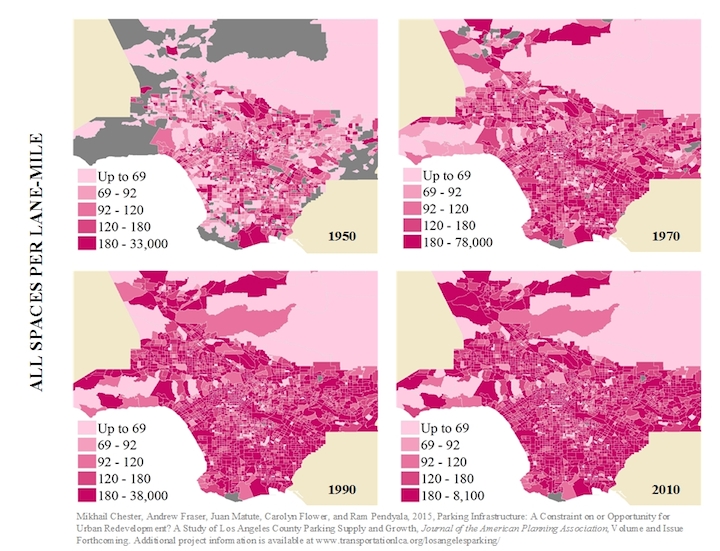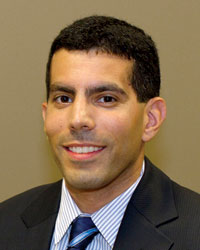
ASU study: Cities need to limit parking to decrease automobile use and encourage public transit

Above: This illustration shows the increase in parking spaces in Los Angeles from 1950 to 2010. The study’s authors found that the parking infrastructure covers 14 percent of the urbanized area of Los Angeles and most of the parking is surface lots for commercial facilities.
If burgeoning cities wish to decrease automobile use to relieve congestion, reduce air pollution, and encourage public transit they need to develop strategies to reduce the number of parking spaces.
A research project led by Arizona State University, in partnership with UCLA and Georgia Tech, analyzed the change in the types of spaces, number of spaces, and location of spaces in Los Angeles from 1900 to present.
The researchers found that most parking was constructed between 1950 and 1980 and there are currently 18.6 million spaces, or 3.3 spaces for each of the 5.6 million vehicles.
“It appears that abundant and underpriced parking infrastructure impacts automobile ownership and use,” said the study’s lead author Mikhail Chester, assistant professor of civil, environmental and sustainable engineering in the Ira A. Fulton Schools of Engineering at Arizona State University.
The research study, “Parking Infrastructure: A Constraint on or Opportunity for Urban Redevelopment? A Study of Los Angeles County Parking Supply and Growth,” is published in the November online issue of the Journal of the American Planning Association.
Most parking spaces in Los Angeles were constructed in response to minimum requirements in zoning ordinances. These requirements are based on the busiest times of day leading developers to build a large number of parking spaces.
According to the authors, these spaces are often underpriced, lowering the time and money costs of driving. This leads to higher vehicle ownership, more traffic congestion, poor air quality, more household spending on mobility, and underused land.
The study’s authors found that the parking infrastructure covers 14 percent of the urbanized area of Los Angeles and most of the parking is surface lots for commercial facilities. The findings suggest that minimum off-street parking requirements have been a success at encouraging greater automobility and “probably a failure” at lowering traffic congestion, one of the original objectives of the requirements.
The authors note that this is the first comprehensive parking inventory of a large city that assesses the growth of the infrastructure over a long time span.
“We found that since 1975, the number of residential off-street parking spaces is equal to the number of vehicles in Los Angeles.” Chester said. “This has important implications. If we want to manage automobile use at a time when many cities are struggling with managing growing congestion, then we should consider reducing parking or pricing it directly.”
Andrew Fraser, a graduate student in engineering at ASU and the study’s co-author added, “The greatest density of parking spaces in Los Angeles is downtown where there is significant investment in public transit. This abundance of parking is likely to work against initiatives to increase transit use, as well as biking and walking.”
Major reforms are needed to ensure that cities build the appropriate amount of parking infrastructure and redevelop the existing parking supply, the authors suggest. Cities should more strongly consider the use of maximum parking restrictions to reduce automobile congestion, while also redeveloping neighborhoods to encourage more transit use, biking, and walking.
They also suggest that minimum parking requirement, which often drive up housing costs, be relaxed where good transit exists.
While these strategies will be valuable, the authors note that cities struggling to manage growing automobile use must also consider how to repurpose parking into more economically productive land uses. This includes redeveloping dedicated surface lots into new buildings, allowing detached home garages to be converted into apartments, and assessing whether multi-story parking structures can be adapted for alternative use.
The study’s other authors include Juan Matute, associate director of the Lewis Center and the Institute of Transportation Studies at UCLA: Carolyn Flower, an undergraduate student in civil, environmental and sustainable engineering at ASU; and Ram Pendyala, a professor in civil and environmental engineering at Georgia Tech.
Additional project information is available online at: www.transportationlca.org/losangelesparking
Media Contact
Sharon Keeler, [email protected]
480-727-5618
Ira A. Fulton Schools of Engineering




































